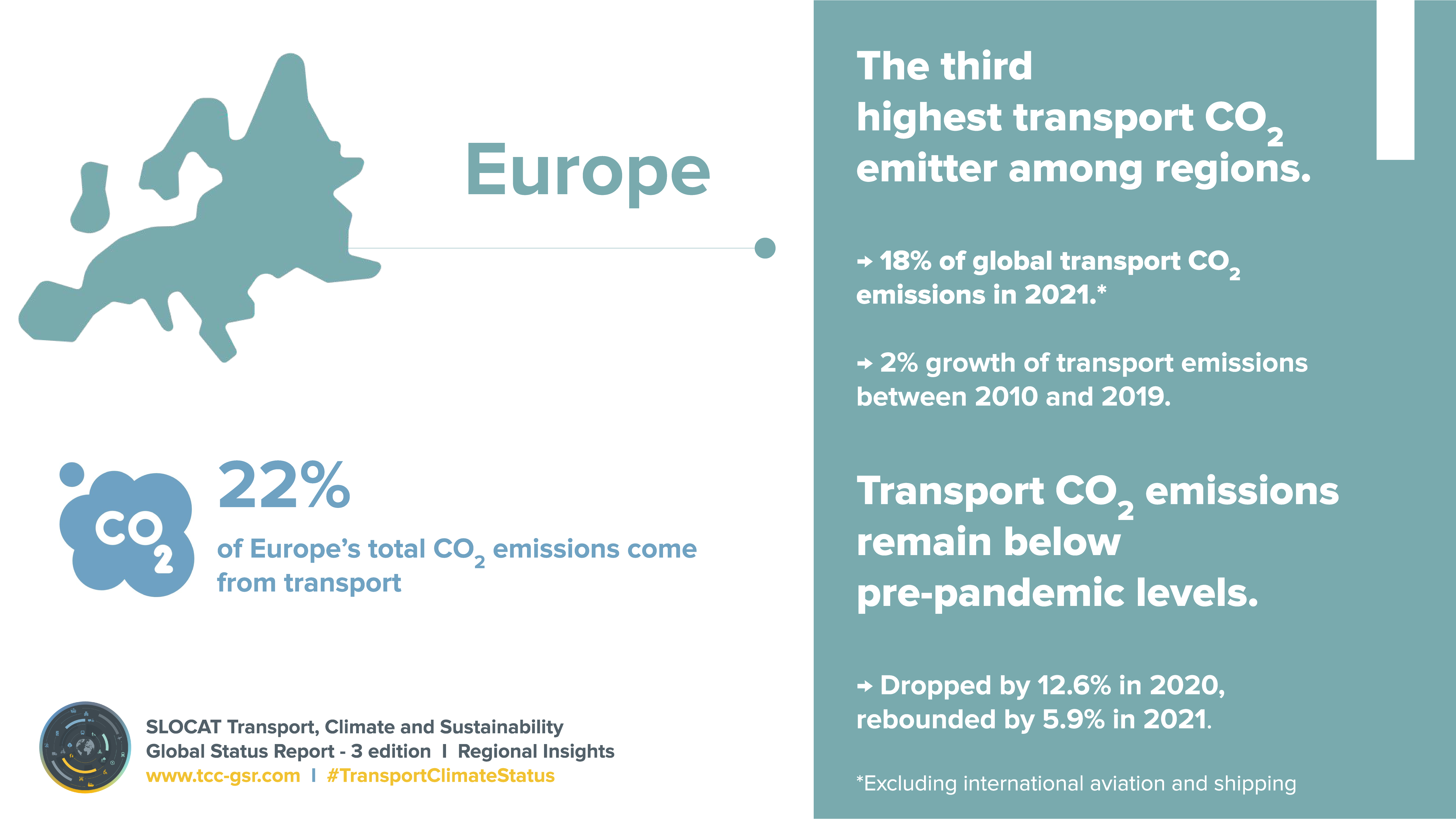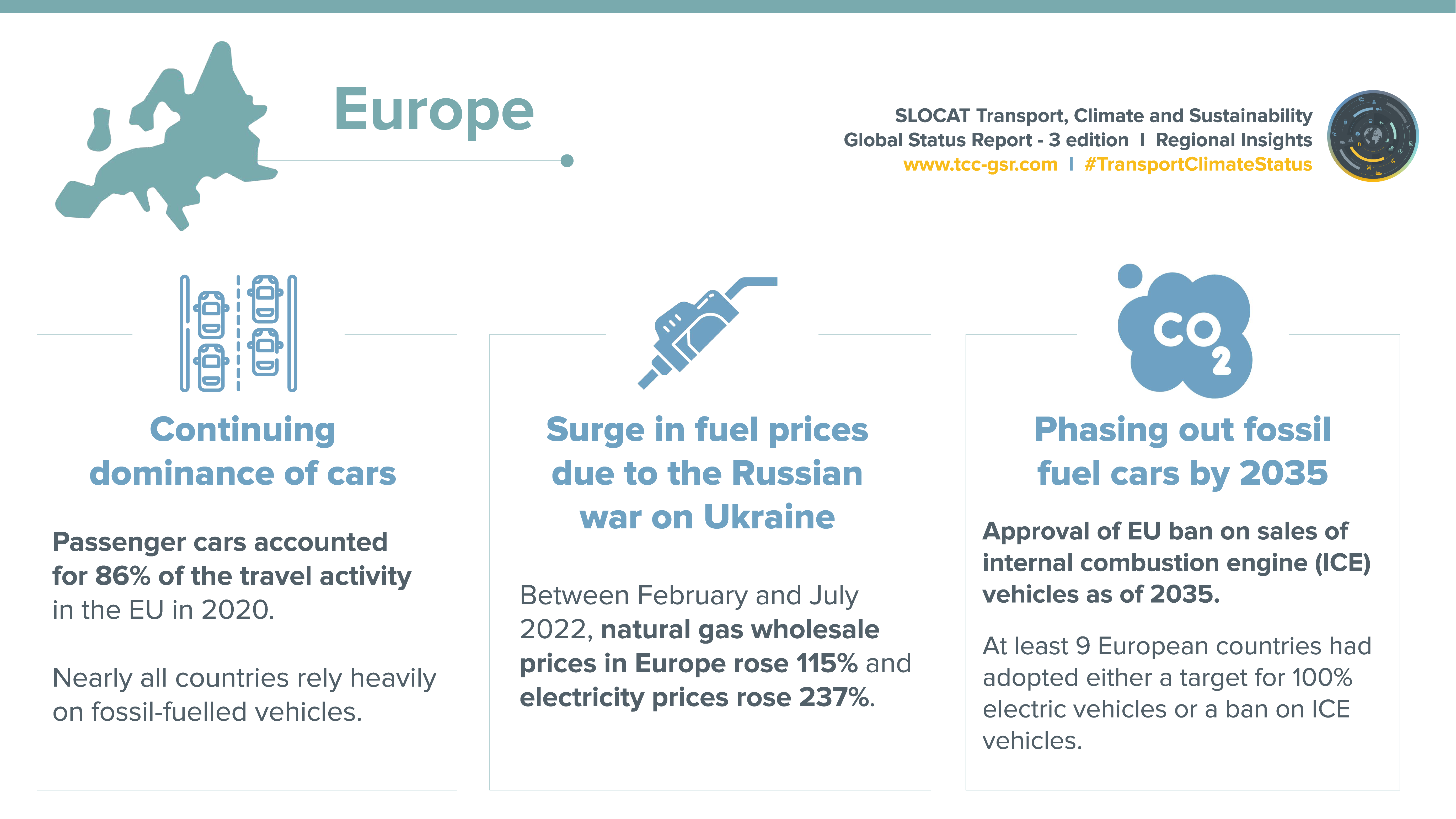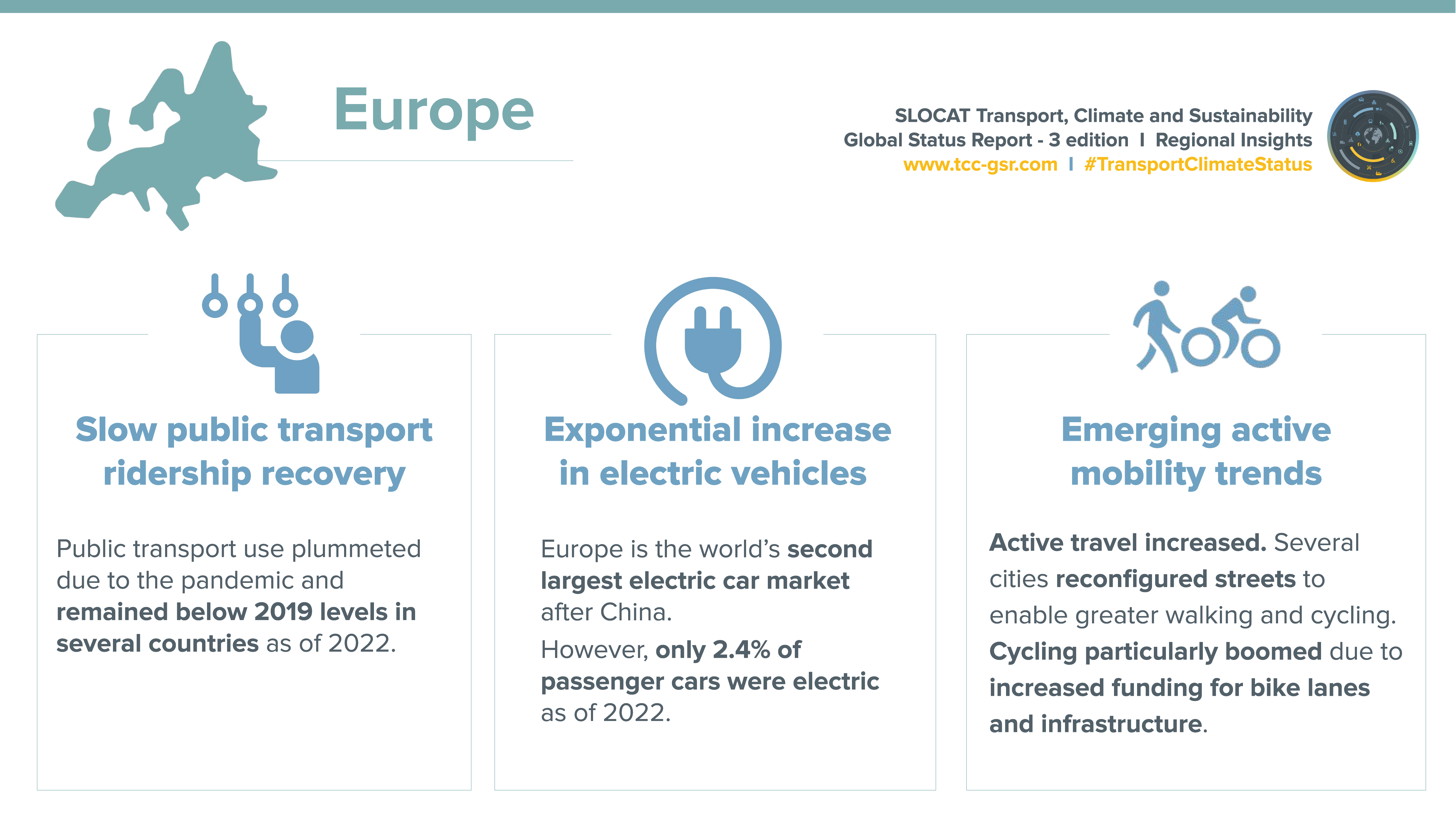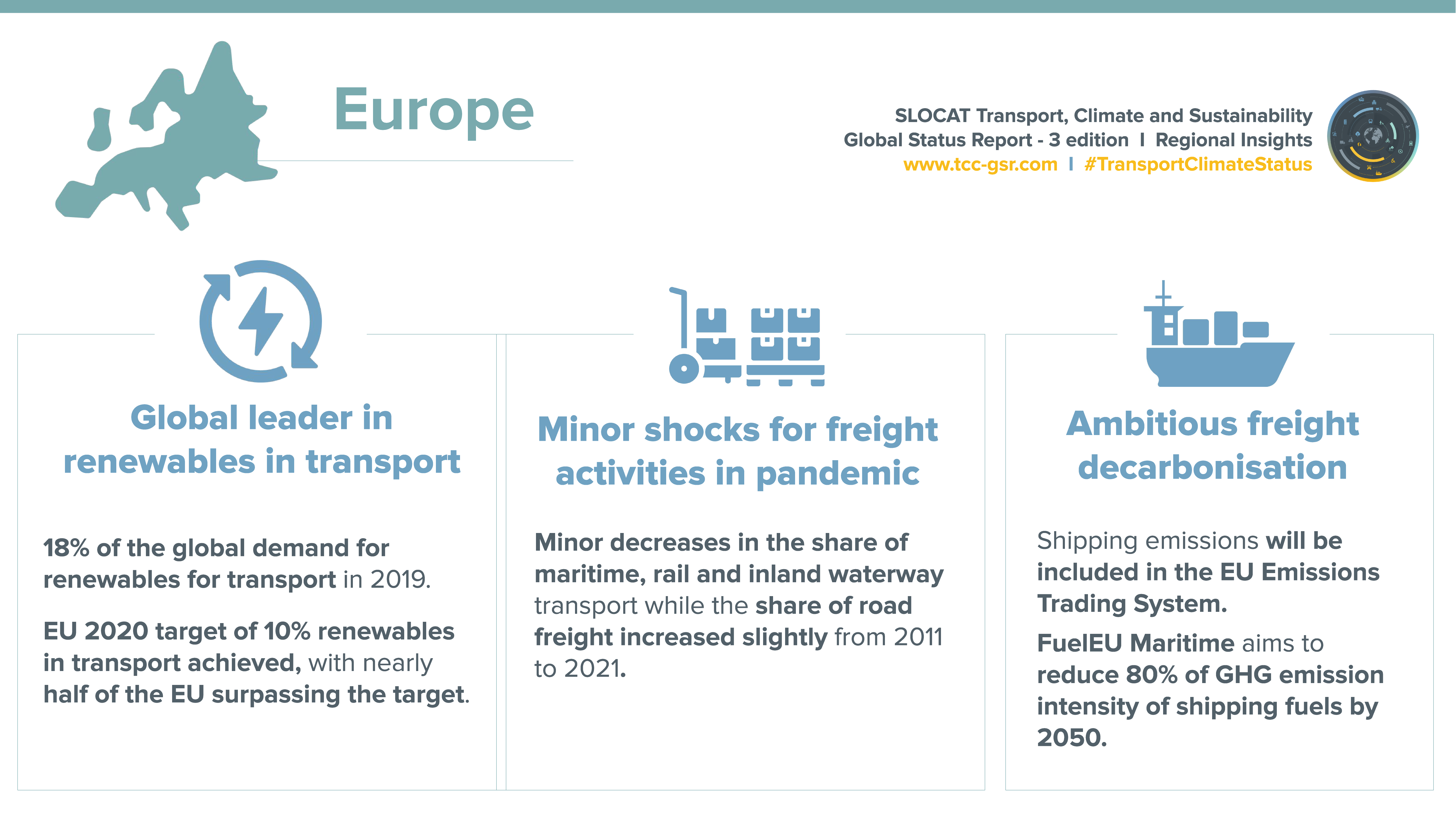-
 Europe Regional Overview
Europe Regional Overview
Population size
(2022)
Population growth
(2010-2022)
%
Urban population share
(2022)
%
Urban population
growth (2010-2022)
%
GDP per capita
(2021)
GDP growth
(2010-2021)
%
- Key Findings
Demand trends
- Passenger cars continued to be the dominant transport mode in the European Union (EU), with an 86% share in 2020 (latest data available). The number of registered passenger cars in the EU reached 253 million in 2021, up 8.6% from 2016. Vehicle preferences across Europe vary by fuel type, but nearly all countries have maintained a heavy reliance on fossil-fuelled vehicles.
- The motorisation rate (covering four-wheeled motor vehicles) continued to vary greatly across Europe, growing around 20% regionwide and 18% in EU countries, on average, during 2010-2020.
- The COVID-19 pandemic resulted in key changes in Europe’s urban areas, as public transport use fell sharply and remained below 2019 levels as of July 2022 in the United Kingdom, the Netherlands, Belgium, Italy and Spain. However, in some countries, such as France and Germany, public transport sectors rebounded to pre-pandemic levels or higher.
- As public transport use declined, active travel increased in many places. Several European cities reconfigured streets to enable greater walking and cycling. Cycling in particular boomed in the region, as many cities dramatically increased funding to support bike lanes and infrastructure. Several major cities continued to have high shares of active travel among all trips as of 2022.
- Europe is the second largest electric car market in the world after China; however, despite high uptake since 2020, only 2.4% of the region’s passenger cars were electric as of 2022. Sales of battery electric and plug-in hybrid cars grew more than 15% in 2022, and over 1.6 million battery-only electric cars were sold, a more than four-fold increase from 2019.
- The electric bus market in Europe grew 26% in 2022, to more than 4,100 registered vehicles, and nearly one-third of the European public bus fleet was reported to be zero-emission vehicles.
- The EU announced in 2022 that it had achieved its 2020 target of 10% renewables in transport (up from just 1.6% in 2004), with 12 of the 27 Member States surpassing the target and Sweden leading at 31.9%.
- The Russian Federation’s invasion of Ukraine in 2022 contributed to rising energy prices worldwide, but the European market was particularly hard hit as countries relied heavily on Russian energy imports. Between February and July 2022, natural gas wholesale prices in Europe rose 115% and electricity prices rose 237%. The Russian war on Ukraine also has resulted in other transport-related impacts, including damage to infrastructure and major disruptions in the sector.
- Air and rail transport in Europe were heavily impacted by the COVID-19 pandemic. Air passenger transport in EU Member States fell 73% in 2020 but rebounded slightly by 2021, growing nearly 40%. Rail transport fell 46% in 2020, following years of an upward trend.
- From 2011 to 2021, the modal split in freight transport remained relatively stable in the EU, with some minor fluctuations and changes in share among modes: shares of maritime, rail and inland waterway transport decreased, and this trend continued through 2022. Meanwhile, the share of road freight increased slightly as it rebounded from the pandemic, and air freight transport remained stable. Maritime transport accounted for more than two-thirds of freight tonne-kilometres in the EU during 2011-2021.
Emission trends
- The transport sector contributed 22% of economy-wide carbon dioxide (CO2) emissions in Europe in 2021. The region’s transport CO2 emissions grew a moderate 2% between 2010 and 2019, then fell 12.6% in 2020; in 2021, they rebounded 5.9% but remained below pre-pandemic levels.
- Europe contributed 18% of the world’s transport CO2 emissions in 2021 (excluding international aviation and shipping), the third largest regional share after Asia and North America.
- Based on measures planned or in place as of October 2022, total transport emissions in the EU were projected to fall below 1990 levels by 2029. In this scenario, only road transport emissions, representing 77% of the EU’s transport greenhouse gas emissions, would decline until 2030. Emissions from other modes would either remain stable or increase, particularly aviation.
- Transport CO2 emissions vary greatly across the region, from 143 million tonnes in Germany to 0.68 million tonnes in Iceland in 2021. On a per capita basis, Luxembourg emitted by far the most CO₂ from transport in 2021, while Ukraine emitted the least.
Policy developments
- With the onset of the COVID-19 pandemic, countries enacted various policy measures to stimulate transport demand, including the European Year of Rail initiative, financial aid to airlines, and many measures supporting active travel, responding to the popularity of temporary cycling and pedestrian infrastructure.
- In 2020, the European Commission released its Sustainable and Smart Mobility Strategy, which lays the foundation towards a green and digital transformation and more resiliency to future crises.
- As part of the European Green Deal, the European Commission adopted four proposals in 2021 aimed at modernising the EU’s transport system to support cleaner, smarter mobility.
- In December 2021, the European Commission presented a proposal for an updated regulation on EU guidelines for the development of the Trans-European Transport Network (TEN-T), following from several initiatives in support of rail in recent years.
- In early 2023, the European Commission proposed updating the 2010 Intelligent Transport System Directive to adapt to emerging road mobility options, apps, and connected and automated mobility.
- By 2022, several European countries had adopted policies and targets aimed at promoting or discouraging certain vehicle types or fuels, and many cities had designated low-emission zones to limit polluting vehicles and improve liveability. Almost all countries in the region had biofuel blending mandates and advanced biofuel targets, in addition to those set at the EU level.
- In early 2023, the EU almost unanimously approved a ban on sales of internal combustion engine vehicles (with an exception for CO₂-neutral e-fuels) as of 2035. By 2022, at least 9 European countries had adopted either a target for 100% electric vehicles or a ban on internal combustion engine vehicles, while 11 countries had announced or made plans for such a target.
- Active low-emission zones in the EU-27, the United Kingdom and Norway increased 40% between 2019 and 2022, with projections for an additional 58% growth by 2025, to reach a total of 507 zones.
- As part of the EU’s Efficient and Green Mobility Package, the EU Urban Mobility Framework was released in December 2021 to guide cities to reduce emissions, improve public health, and make urban mobility smarter and more sustainable. The framework foresees that all major cities in the network develop a sustainable urban mobility plan (SUMP) by 2025.
- Across Europe, the number of SUMPs increased from 800 in 2013 to 1,000 in 2018, with several cities having updated their SUMPs at least once.
- With the Russian invasion of Ukraine and the subsequent spike in energy prices, countries across Europe offered relief to consumers by providing subsidies for fuel and public transport. The European Commission also enacted fuel subsidies, and in May 2022 it released the REPowerEU plan, which includes a strategy to shift to imports of non-Russian gas and oil alongside accelerated adoption of renewable energy and energy conservation efforts.
- Specifically for freight, the European Commission provisionally agreed in 2022 to include emissions from shipping in the EU Emissions Trading System, and in 2023 it adopted FuelEU Maritime, aimed at reducing the greenhouse gas emission intensity of shipping fuels 80% by 2050.
Authors: Hannah E. Murdock, Imperial College London; Arjay Dineros, SLOCAT Secretariat
Contributor: Mark Major, Kühne Foundation

